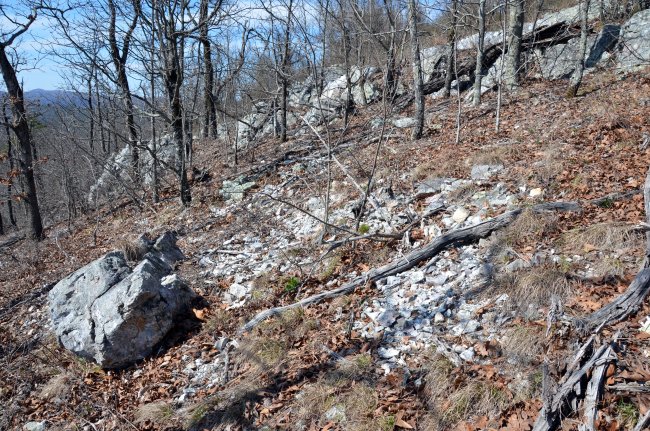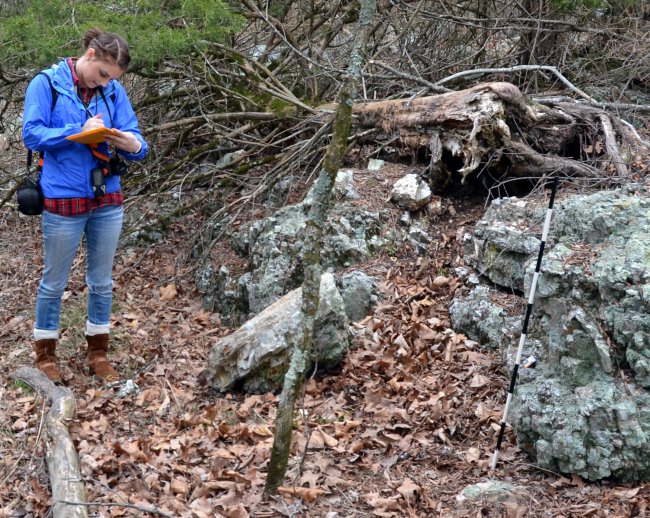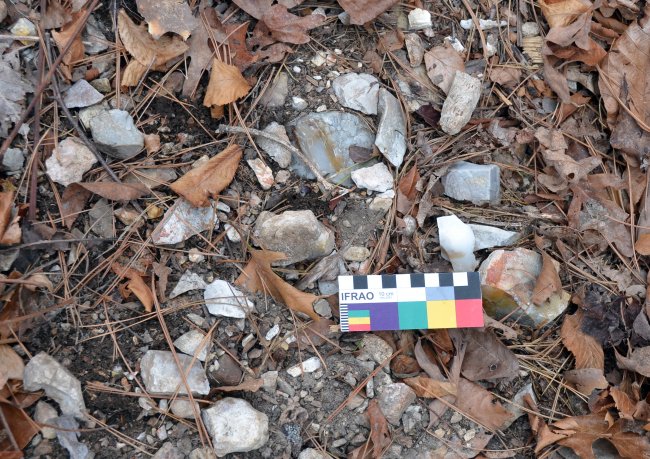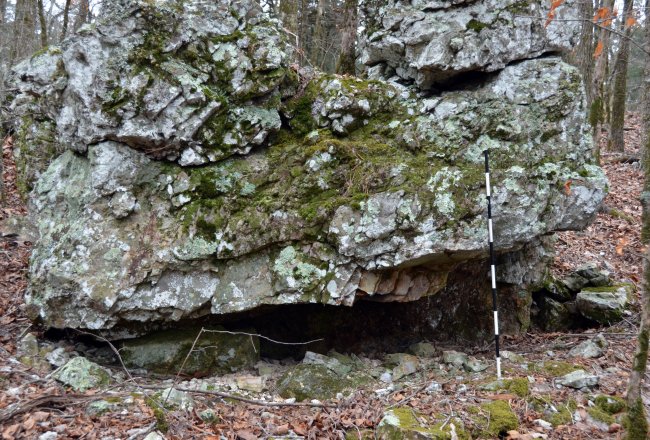Novaculite Quarries: Polk County

Novaculite boulders and debris on a mountain ridge in Polk County.
Novaculite bedrock is exposed on the steep mountain ridges in the Ouachita Mountains of western Arkansas. Native Americans quarried novaculite from numerous ridge-top locations in Polk County. Later Arkansans prospected for novaculite, manganese, or other resources here. Many of these locations are now recorded as archeological sites.

Henderson State University student Kalyn Duggan records information at novaculite quarry 3PL770.
One novaculite quarry in Polk County, recorded as archeological site 3PL349, was the site of a mapping and testing project as part of the 1993 Arkansas Archeological Society Training Program. The team, led by Jerry Hilliard, created a scale map of the novaculite ridge crest, showing boulders, concentrations of novaculite chipping debris and sandstone hammers, and a possible quarry trench. They excavated two 1x1 meter square test units in an area of boulders and surface flakes. A large quantity of novaculite debris was collected from the 20 centimeters above battered novaculite bedrock.

Map of Novaculite Quarry 3PL349 showing locations of 1993 test excavation units A and B (from Hilliard 1999:Figure 22).
Over several years, Mary Beth Trubitt (Arkansas Archeological Survey), with Arkansas Archeological Society members and Henderson State University students, analyzed materials from that 3PL349 quarry excavation. Thanks to an Arkansas Archeological Society grant, Mary Beth Trubitt and Aswa Khan have now finished the analysis. The quarry site had some naturally-broken novaculite pieces that were weathered on all surfaces. In contrast, the waste fragments left by Native people who quarried toolstone there in the past had relatively fresh breaks. Artifacts included pieces of chipping debris in the form of angular shatter, flakes, and flake fragments. Over half of chipping debris from the excavations had some cortex or weathered surfaces. A few cores, bifacially flaked pieces, and utilized pieces of novaculite were found in TU A and B. Two sandstone hammers and a metate fragment were collected from the surface. While there were no diagnostic chipped stone tools to identify the timing of quarry activity, one nineteenth-century whiteware ceramic sherd and one Caddo period grog-tempered plain sherd show people visited the quarry during the last millennium at least.

Pieces of angular debris or shatter are commonly seen at novaculite quarry sites.
From Quarry to Workshop to Camp
The different stages of stone tool production – quarrying the raw material, initial testing by chipping, heat treatment, further thinning and reduction, and shaping the final tool – were done at different locations. Because by-products of stone tool manufacturing are durable, archeologists can track the process across the region by examining the kinds of novaculite artifacts found at different sites. What activities were done at quarries, at workshops, and at camps? In what form did Native Americans transport novaculite, and what was left behind?

The reduction of novaculite – from blocky pieces to finished tools – was done at different locations.
At the Arkansas Archeological Survey’s Henderson State University Research Station, we have developed a system that combines mass analysis of novaculite chipping debris with individual analysis of novaculite flakes. One step is size-sorting novaculite debitage (chipping debris) from excavations. Patterns emerge from comparisons between different types of sites.
For example, at quarry site 3PL349, there are many large pieces of novaculite chipping debris. The debris caught in the 2.5 cm (1”) geological sieve makes up the bulk (73%) of the overall weight. Comparing between sites, chipping debris left on quarries tends to be large and bulky, while debris discarded at workshops and habitation sites is smaller in size and lighter in weight. As novaculite was carried further from the quarry and chipped into tools, pieces were reduced in size and smaller debitage was discarded.

Comparisons of novaculite chipping debris size profiles from three quarry sites, a workshop site, and three habitation sites. Note that quarries 3PL349 and 3GA48 have nearly identical frequencies.
There have been archeological excavations at three novaculite quarry sites in Arkansas’s Ouachita Mountains, so we can compare the 3PL349 results to those from two sites in Garland County, 3GA22 and 3GA48. All three are similar in terms debitage size profiles, with between 70 and 80% of the assemblage weight in the >2.5 cm category. Most of the chipping debris at the quarries takes the form of angular shatter (86% of chipping debris >1.25 cm by count from 3PL349, compared with 95% from 3GA22) with lower proportions of flakes or flake fragments. In the analysis of 3PL349, 3GA22, and 3GA48 quarries, fewer than 1% of the excavated artifacts were identified as cores, biface fragments, tools, or hammerstones. One difference was that two dart points were excavated at the 3GA48 quarry, indicating that quarrying took place during the Middle to Late Archaic period (ca. 4,500-1,000 B.C.). Another difference was that more hammerstones were found at 3GA48 as compared with 3PL349 and 3GA22.

Examples of novaculite flakes from 3PL349 quarry.
Protecting Significant Historic Places
Archeological sites on federal and Indian lands are protected by federal laws. The Archaeological Resources Protection Act sets penalties for unauthorized digging at or damaging sites on public lands or removing artifacts from these historic places. It also sets up procedures for permitting qualified professional archeologists to conduct research at sites on public lands. State laws protect archeological sites on state-owned lands in Arkansas as well.
Please help to preserve these large and significant archeological sites. The novaculite quarry pits and tools left behind can tell us the unwritten history of this ancient industry. These sites are part of America’s heritage!
Site visits to photograph novaculite quarries as part of this website project have been made with permission from the Ouachita National Forest, Hot Springs National Park, Arkansas State Parks, and individual property owners.

A novaculite boulder with undercut feature at 3PL770 (scale is 1 meter).
Comparative Collection
For photographs and descriptions of raw material samples from Polk County, select a site below or go to the Comparative Collection page.
Read more about archeological research on Polk County quarries and analysis of novaculite tool production:
Andrefsky, William, Jr., editor (2001) Lithic Debitage: Context, Form, Meaning. University of Utah Press, Salt Lake City.
Bradbury, A. P. and P. J. Carr (2004) Combining Aggregate and Individual Methods of Flake Debris Analysis: Aggregate Trend Analysis. North American Archaeologist 25(1):65-90.
Etchieson, Meeks and Mary Beth Trubitt (2013) Taking it to the River: Arkansas Novaculite Quarrying and Archaic Period Tool Production. North American Archaeologist 34(4):387-407.
Hilliard, Jerry (1999) A Preliminary Report on 3PL349, a Novaculite Quarry Site. The Arkansas Archeologist 38:22-24.
Trubitt, Mary Beth (2007) The Organization of Novaculite Tool Production: Quarry-Workshop Debitage Comparisons. Caddo Archeology Journal 16:71-89.
Trubitt, Mary Beth (2016) Monitoring and Archeological Documentation at 3GA22, Hot Springs National Park, Garland County, Arkansas. Report on file, Arkansas Archeological Survey, Arkadelphia and Fayetteville.
Trubitt, Mary Beth (2017) Update on Spanish Diggings Novaculite Quarry Research. Field Notes (Newsletter of the Arkansas Archeological Society) 399:3-8.
Trubitt, Mary Beth D., Anne S. Dowd, and Meeks Etchieson (2013) Multiscalar Analysis of Quarries. The Quarry (e-newsletter of the Society for American Archaeology’s Prehistoric Quarries & Early Mines Interest Group) 10:30-43.
Trubitt, Mary Beth, Thomas Green, and Ann Early (2004) A Research Design for Investigating Novaculite Quarry Sites in the Ouachita Mountains. The Arkansas Archeologist 43:17-62.
Suggested citation format for this website:
Arkansas Archeological Survey 2016 "Arkansas Novaculite: A Virtual Comparative Collection."
http://archeology.uark.edu/novaculite/index.html (accessed January 15, 2016).
We welcome comments and feedback from you! For further information on this website, please contact Mary Beth Trubitt, Arkansas Archeological Survey, mtrubit@uark.edu.
This project is supported in part by a grant from the Arkansas Humanities Council and the National Endowment for the Humanities.
Copyright 2012, 2013, 2014, 2015, 2016 Arkansas Archeological Survey
A Division of the University of Arkansas System
2475 North Hatch Avenue
Fayetteville, AR 72704
479-575-3556
arkarch@uark.edu




